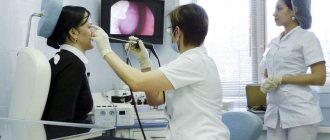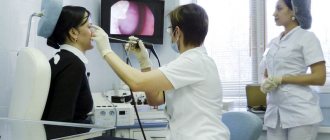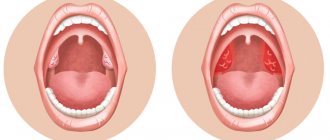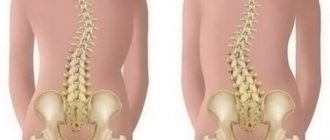From this article you will learn:
- what is ethmoiditis,
- ethmoiditis - symptoms and treatment (conservative and surgical).
Ethmoiditis is an inflammation of the ethmoid sinus (ethmoid sinus). Often, inflammation of the ethmoid sinus is called the general term “sinusitis,” which should be understood as inflammation of any of the four pairs of paranasal sinuses.
The paranasal sinuses (in addition to the ethmoid sinus) also include -
- maxillary sinuses - their inflammation is called “sinusitis”,
- frontal sinuses - their inflammation is called “frontitis”,
- sphenoid sinuses - their inflammation is called “sphenoiditis”.
The ethmoidal sinus is paired (Fig. 1). Each ethmoid sinus consists of many small cavities in the bone (microsinuses), filled with air and lined from the inside with mucous membrane. The sinus has an oblong shape and is elongated in the anteroposterior direction.
Ethmoiditis: photo, diagram
An important anatomical feature of the ethmoid sinus is
the microsinuses of the anterior part of the sinus (located closer to the surface of the face) communicate through a small opening with the middle nasal passage; The microsinuses of the posterior part of the sinus, located closer to the base of the skull and the sphenoid sinus, communicate with the upper nasal passage.
Accordingly, when the anterior part of the sinus is inflamed, inflammatory exudate and pus will flow into the middle nasal passage, and when the posterior part of the sinus is inflamed, into the upper nasal passage. An ENT doctor will see all this when examining the nasal passages. This is important for the diagnosis and determination by the doctor of the treatment strategy for ethmoiditis. In general, ethmoiditis is an extremely dangerous disease, and if not treated in a timely manner, it can result in an orbital abscess, brain abscess, sepsis...
1.General information
The normal anatomy of the adult skull provides for the presence of four groups of air cavities, evolutionarily designed, apparently, to perform several functions: reduction of the total mass of the skull, pre-treatment of inhaled air, thermal insulation of abundantly innervated maxillofacial structures, shock absorption, creation of an acoustic resonator for processes phonation and articulation of speech. These cavities, or sinuses, are located in the bones of the upper jaw (maxillary sinuses), frontal bone (frontal sinuses), ethmoid labyrinth and sphenoid bone (the cavity in which is the only unpaired paranasal sinus). All paranasal sinuses, or paranasal sinuses, are covered from the inside with mucous membrane and have exits into the nasal cavity, which provides the necessary ventilation and drainage of secretions.
Sinusitis is the general name for inflammation in the paranasal sinuses, without taking into account the specific location. Accordingly, there are four local variants of sinusitis: sinusitis, frontal sinusitis, ethmoiditis and sphenoiditis, as well as generalized pansinusitis and unilateral hemisinusitis.
Ethmoiditis, therefore, is a special case of sinusitis, when the inflammatory process develops in the mucous membrane of the ethmoid bone.
The ethmoid bone is located approximately at the level of the bridge of the nose, deep from the latter, above the upper jaw and under the frontal bone, and its back part borders on the sphenoid bone; in general, it is located in close proximity to the intracranial space occupied by brain structures. It does not have a solid, but a distinctly cellular structure, which is why it got its name.
Ethmoiditis, according to modern data, is much less common than sinusitis and frontal sinusitis; Moreover, due to a number of age-related characteristics (infantile structure, childhood infections), they are more common in children. The incidence does not depend on gender; acute and chronic forms are recorded with approximately equal frequency (according to other sources, acute ethmoiditis slightly predominates). The disease is characterized by a fairly high risk of complications, including severe ones.
A must read! Help with treatment and hospitalization!
Ethmoiditis: causes
As we said above: the sinuses of the ethmoid sinus are lined from the inside with mucous membrane, and communicate with the nasal passages through small openings. This mucous membrane has a large number of glands that produce mucus, and its surface layer is covered with ciliated ciliated epithelium (the cilia of which move, thereby facilitating the removal of mucus from the sinuses into the nasal passages).
This active transport mechanism (plus ventilation of the sinuses through the openings) ensures healthy sinuses. If the removal of mucus from the sinuses is blocked, then it accumulates there, and this is what contributes to the development of infection and subsequent suppuration.
Factors that can cause sinus inflammation:
- Acute respiratory viral infections (ARVI and influenza) - the virus sharply increases the production of mucus in the sinuses and nasal passages, and also causes the development of swelling of the mucous membranes of the nose and sinuses.
Swelling of the mucous membranes leads to the closure of the holes through which mucus from the sinuses enters the nasal cavity. In addition, viral toxins block the motor activity of the ciliated epithelium of the mucous membrane, which also disrupts the removal of mucus from the sinuses. At the initial stage, inflammation in the sinuses is of a serous nature, i.e. no pus is found in the sinuses. But gradually, in the confined space of the sinuses (in the absence of ventilation and the presence of a large amount of mucus), a bacterial infection develops, which leads to the formation of pus in the sinuses. - Chronic inflammatory diseases of the nose (chronic rhinitis) - chronic inflammation of the nasal passages is usually of a bacterial nature.
Pathogenic bacteria and their toxins also contribute to swelling of the mucous membranes of the nose and sinuses, lead to nasal congestion, and increase mucus production in the nose and sinuses. All this leads to the formation of pus in the sinuses. Also, low-grade chronic inflammation can lead to the formation of polyps in the sinuses and nasal passages. - Allergic rhinitis – with allergic rhinitis there is also a sharp increase in mucus production and swelling of the mucous membranes. As a result, serous ethmoiditis may initially occur in the ethmoid sinuses, in which there are no signs of purulent infection. But over time (if the drainage of mucus from the sinuses is not established), a bacterial infection may develop, and ethmoiditis may turn purulent.
- Factors contributing to the development of ethmoiditis – → deviated nasal septum, → adenoids, polyps in the nasal passages, → active and passive smoking, → chronic inflammatory diseases of the nose, tonsils...
Diagnostics
Regardless of whether you contact an ENT specialist or a therapist, a detailed story about your illness should always be detailed - this is an integral part of the diagnosis .
Subsequent palpation of the nose and face may provide additional important information for the diagnosis of ethmoiditis and other forms of sinusitis. Laboratory tests such as a complete blood count including inflammatory triggers or a nasal swab are often done.
For a more accurate examination of the mucous membrane and nasal cavity, and to evaluate data in the paranasal sinuses, nasal endoscopy is recommended. A nasal endoscope can also be used to take tissue samples (biopsy) to diagnose or remove polyps.
Imaging methods (ultrasound, MRI, CT) can help for an accurate diagnosis. They are used, in particular, to determine whether surgery is necessary. CT imaging is preferred for diagnosing sinusitis because CT images can reproduce bone changes very accurately.
Sign up for a consultation
Ethmoiditis: symptoms
Ethmoiditis can have an acute and chronic course. Acute ethmoiditis occurs, as a rule, against the background of acute respiratory viral infections and influenza, or allergic rhinitis. Acute ethmoiditis is characterized by severe symptoms. Chronic ethmoiditis, in turn, has sluggish symptoms; with it, very often the formation of polyps can be seen in the nasal passages and sinuses themselves. Occasionally, with chronic ethmoiditis, the patient's complaints may be completely absent.
The main symptoms that patients may complain about are:
- headache (mainly in the area between the eyes),
- pain in the bridge of the nose and the inner corners of the eyes,
- swelling of the eyelids (especially in the morning after waking up),
- prolonged runny nose (more than 7-10 days),
- mucous or mucopurulent discharge from the nose,
- drainage of mucus and pus along the back wall of the throat (if the posterior microsinuses of the ethmoid sinus are affected).
Photo of a patient with purulent right-sided ethmoiditis (if the serous process turns purulent, then the eyelids can no longer just swell, but they become red and swollen):
More general symptoms observed with ethmoiditis -
- swelling of the face,
- headache, fatigue, fever,
- sore throat, cough,
- bad breath,
- decreased sense of taste and smell.
Important : the ethmoid sinuses are separated by very thin bony walls from the eye sockets, so when inflammation passes from serous to purulent, more serious symptoms may appear: loss of vision, double vision, redness of the eyes and eyelids, protrusion of the eyes forward. It should also be taken into account that inflammation of the anterior part of the ethmoid sinus usually occurs simultaneously with damage to the maxillary and frontal sinuses, and the posterior part - with inflammation of the sphenoid sinus.
Consequences
Complications of ethmoiditis develop when a person does not seek medical help for a long time, and the pathological process continues to progress. In most cases, they are infectious and inflammatory in nature - the causative microorganisms spread to nearby structures. This leads to the development of tonsillitis - acute inflammation of the tonsils. Ethmoiditis in children, due to the well-developed blood vessels, can cause involvement of the meninges (meningitis) or brain tissue (encephalitis).
The ethmoid bone is directly adjacent to the orbit, so the process easily transfers to the periorbital tissue. It can be limited (orbital abscess) or diffuse (orbital phlegmon). In this case, acute pain appears in the area of the eyeball, but there is no impairment of visual functions. Such patients require urgent help, not only from an otolaryngologist, but also from an ophthalmologist. Doctors of these specialties work at NEARMEDIC, so they jointly treat the patient so that recovery occurs quickly and fully.
All sinuses communicate with each other, so ethmoiditis in adults and children can additionally be complicated by inflammation of one or all sinuses at once. The likelihood of this complication is increased by strong nose blowing, when high pressure is created inside the airways. Under such conditions, microorganisms easily penetrate the accessory sinuses. Therefore, you should not blow your nose; you just need to gently blot it with a napkin to remove the inflammatory secretion. It is also good to rinse it with salt (sea) water or use an aspirator.
Against the background of reduced immunity, bacteria or other pathogens can descend into the underlying parts of the respiratory tract. This causes bronchitis and pneumonia. In this regard, ethmoiditis in children can even lead to bronchial asthma, because Against the background of prolonged inflammation, the muscles of the bronchi easily spasm (contract) even under the influence of minor irritants.
How is ethmoiditis diagnosed?
As a rule, inflammation of the ethmoid sinuses is diagnosed by an ENT doctor based on the patient’s complaints and the results of an examination of your nasal passages. The doctor will check the patency of your nasal passages, the presence of swelling of the mucous membrane, polyps or purulent discharge in the nasal passages, and the presence of adenoids. However, the absence of purulent exudate from the ethmoid sinuses cannot indicate the mandatory absence of ethmoiditis, because in conditions of severe swelling of the sinus mucosa, they can be completely blocked.
Additional research methods - 1) Computed tomography (CT) will determine the degree of inflammation of the ethmoid sinus, the presence of polyps and pus in it. It is especially important to carry it out if the patient has symptoms indicating that the infection has spread to the area of the orbits or other paranasal sinuses. 2) X-ray examination is possible, but unlike CT, it is very little informative for this pathology. 3) Ideally, if your doctor notices heavy nasal discharge, they will take a mucus sample for microbiological testing. This will allow you to determine the nature of ethmoiditis (viral, bacterial or allergic). If the cause is an allergy, then many eosinophils will be found in the mucus.
Establishing diagnosis
Diagnosis of ethmoiditis is carried out by an otolaryngologist. Based on a patient interview and examination data, a preliminary diagnosis is made.
To confirm it and determine the exact location of the inflammation, additional examinations are prescribed.
- CT scan. The most informative method. Allows you to evaluate the anatomical structure of the sinuses, the presence of bone deformations, polyps, adenoids, and the degree of damage to the mucous membranes. Accurately shows the location of the source of inflammation, its spread to other paranasal sinuses and the orbit.
- Endoscopy. Instrumental method for examining the nasal concha and ethmoidal labyrinth. Allows you to assess the degree of inflammation, as well as the presence of pathological formations. If necessary, a sample of the epithelium and discharge are taken for examination.
- Radiography. An old, but quite informative method. Pictures are taken in several projections. Shows the location of the pathological focus and its distribution.
- Bacteriological culture of sputum. Allows you to accurately identify the pathogen and determine its sensitivity to antibiotics. Used to select therapy.
Ethmoiditis: treatment
Treatment can be conservative and/or surgical. The choice of treatment tactics will depend on your symptoms, the cause of the development of ethmoiditis, as well as the nature of the inflammatory process (serous, purulent or polyposis).
Treatment of acute ethmoiditis -
Treatment for ethmoiditis, as a rule, is conservative, but this is only in situations where suppuration of the ethmoid sinus has not yet occurred. The main goal of conservative therapy is to restore the patency of the nasal passages, relieve swelling of the mucous membrane in order to restore the outflow of mucus and inflammatory exudate from the sinuses into the nasal cavity.
For this, nasal drops and sprays + systemic anti-inflammatory drugs based on ibuprofen can be used. The patient should also regularly rinse his nose with saline solutions and try to sleep with his head elevated, because this promotes the outflow of exudate from the sinuses (24stoma.ru).
Drops to relieve nasal congestion - you need to keep in mind that traditional vasoconstrictor drops for a runny nose can be used for sinusitis for no more than 2-3 days, because addiction to them quickly develops and they only begin to aggravate the inflammation. To relieve nasal congestion and swelling of the mucous membrane with ethmoiditis, it is optimal to use -
- Spray “Rinofluimucil” (Italy, price about 250 rubles) –
the drug consists of 2 active components that reduce the secretion of mucus and facilitate its discharge, and also relieve swelling from the nasal mucosa. This drug will work well with the drugs Sinupret and Sinuforte, which stimulate the evacuation of inflammatory exudate from the sinuses.
- Spray “Nasonex” (Belgium, price from 500 rubles) –
contains a low dosage of glucocorticoids as an active component. The spray relieves nasal congestion well (especially with allergic rhinitis), plus it can be used for a long time (in courses of 2 or 3 months). Nasonex will also be perfectly combined with stimulants for the discharge of mucus from the sinuses (drugs "Sinupret", "Sinuforte").
Preparations that stimulate the discharge of mucus from the sinuses - there are several herbal preparations that can enhance the function of the ciliated epithelium of the mucous membrane. This leads to accelerated evacuation of mucus and pus from the sinuses into the lumen of the nasal passages through the openings between them.
- The drug "Sinupret" (Germany, price from 350 rubles) –
Available in the form of drops and dragees. Contains extracts of medicinal plants that have an anti-inflammatory effect and facilitate the evacuation of mucus and inflammatory exudate from the sinuses.
- The drug "Sinuforte" (Spain, price from 2300 rubles) –
Available in the form of nasal drops. Contains only plant components. Just like the previous drug, it also promotes the evacuation of pus, mucus and inflammatory exudate from the sinuses.
Treatment of acute ethmoiditis of an allergic nature - in case of acute ethmoiditis of an allergic nature, treatment consists of avoiding contact with allergens, desensitizing therapy with antihistamines, corticosteroids, antiallergic nasal sprays with low concentrations of glucocorticoids (for example, Nasonex spray), and the use of calcium supplements.
Surgical treatment of acute ethmoiditis - in the case of the development of alarming symptoms, such as exophthalmos, limited mobility of the eyeball, loss of visual acuity - urgent initiation of intensive therapy is necessary, including intravenous antibiotics. If there is no positive dynamics with such therapy (and even more so if the symptoms worsen), urgent surgical intervention is necessary. The operation can be performed endoscopically (from inside the nose), as well as through external access through an incision in the corner of the palpebral fissure.
Treatment of chronic ethmoiditis -
In chronic ethmoiditis (both catal and purulent), polyps, as a rule, form in the sinuses and nasal passages, the presence of which requires their mandatory surgical removal.
Why does the disease occur?
Inflammation of the sinuses occurs when they are infected with pathogenic microflora - most often staphylococci and streptococci. Although viral and fungal ethmoiditis also occur.
The ethmoid labyrinth itself rarely becomes inflamed. Usually the disease is a complication of colds, acute respiratory viral infections and other nasopharyngeal infections.
Therefore, it is extremely important to treat nasopharyngeal diseases in a timely manner and only under the supervision of an ENT doctor. This is the surest way to avoid complications and prevent inflammation from spreading to the sinuses.
Other prerequisites for ethmoiditis are:
- “children’s” diagnoses - scarlet fever, measles, rubella, etc.
- chronic diseases of the ENT organs: sinusitis, rhinitis, tonsillitis;
- incorrect or delayed treatment of other forms of sinusitis (if sinusitis or sinusitis is not treated, ethmoiditis can develop as a complication);
- adenoids or their inflammation (diagnosis of “adenoiditis”);
- mechanical injuries and damage to the skull, including after surgical interventions;
- structural features of the nasal cavity (for example, a deviated nasal septum);
- presence of polyps;
- weakened immunity (long-term treatment with antibacterial drugs, HIV, diabetes mellitus, cancer, etc. can provoke a decrease in immunity).
If the disease is not treated in time, the inflammation can become chronic, when the symptoms of ethmoiditis return several times during the year.
Antibiotics for ethmoiditis -
As we wrote above: acute frontal sinusitis most often develops against the background of acute respiratory viral infections and influenza, and antibiotics, as is known, do not act on viruses. Taking antibiotics for acute frontal sinusitis only makes sense if a bacterial infection occurs and purulent inflammation develops, but this does not happen immediately.
If there are indications for taking antibiotics, then the drug of first choice is Amoxicillin in combination with Clavulanic acid. Preparations that contain this combination: “Augumentin”, “Amoxiclav”. If the patient is allergic to antibiotics of the penicillin group, then it is better to use -
- antibiotics of the fluoroquinolone group (for example, Ciprofloxacin),
- or macrolides ("Clarithromycin", Azithromycin).
Antibiotics for frontal sinusitis are prescribed for approximately 10-14 days. However, after 5 days from the start of treatment, it is necessary to evaluate the effectiveness of therapy. If significant improvement is not achieved, then it is best to prescribe a more potent antibiotic.
Prevention
To prevent a child from getting ethmoiditis or other ENT diseases, he must be hardened, runny nose and sore throat treated in a timely manner, and taken to the dentist at least once every 6 months. A child with a tendency to allergies should be seen by an allergist and follow his recommendations.
The Aqualor line of drugs is also perfect for seasonal prevention of ARVI. In the autumn-spring period, it is useful to rinse the nasal cavity at least 2 times a day. You should accustom your child to this procedure, just like brushing your teeth.
Prevention of neonatal ethmoiditis involves proper management of pregnancy and childbirth.
Complications of ethmoiditis -
The most common complications are: intracranial meningitis, thrombophlebitis of the head veins, orbital abscess, brain abscess. If complications are suspected, urgent hospitalization is necessary, because wasting time can lead to loss of health and even death of the patient. We hope that our article on the topic: Ethmoiditis symptoms, treatment in adults - turned out to be useful to you!
Sources:
1. Higher prof. the author's education in surgical dentistry, 2. Based on personal experience in maxillofacial surgery and surgical dentistry, 3. National Library of Medicine (USA), 4. “Guide to maxillofacial surgery” (Timofeev A.A.), 5 "Surgical dentistry and maxillofacial surgery" (Kulakov A.).
How to make an appointment with a specialist
You can make an appointment with an otolaryngologist in the center of Moscow on our website. To do this, click on the “Make an appointment with a doctor” button located at the top of the page. After this, indicate your name, phone number, consent to the processing of the personal data provided, and click on the “Submit” button. Our operator will contact you by calling the phone number specified when filling out the form.
You can also make an appointment at our clinic in the central district of the capital by calling (24 hours a day). Our specialists will answer you as quickly as possible.
Our clinic is located at the address: Moscow, Central Administrative District, 2nd Tverskoy-Yamskaya Lane, 10 (metro stations Mayakovskaya, Tverskaya, Novoslobodskaya).
If you find symptoms of ethmoiditis in your child and he needs urgent medical care, call +7(495)229-00-03. An ambulance team will arrive at the address you specified to provide qualified medical care to your child.
Now you know about ethmoiditis and what kind of disease it is in children. The main thing to remember is that you cannot delay treatment for your child. This disease can lead to the development of dangerous complications that will threaten not only the health, but also the life of the child.







